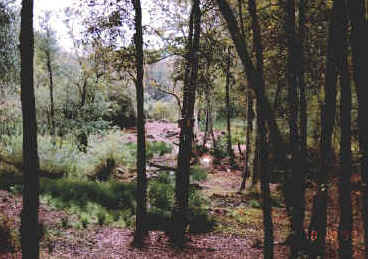The Wetlands Restoration Project
The Marsh Area
The Result This is now a very valuable Marsh area which contains small pools. These pools are a spawning ground for frogs. Grass Snakes are frequently seen. In the summer, Skimmer dragonflies lay their eggs in the pools. Here Willow grows as a thicket. This favours summer migrants such as Chiff Chaff and Willow Warbler. In winter both Woodcock and Snipe use this area. Roe deer visit year round. |

Clearance of the Marsh Area completed some regeneration is occurring
Note the bare areas where rhododendron grew.
 |
Left: The
Marsh in winter, nearly 10 years after restoration. Greater Tussock Sedge and trees such
as Alder and Willow dominate the areas where there is little or no standing water. In the
small pools Broad-leaved Pond Weed proliferates. The Willow is selectively coppiced partly to prevent excess shading but also to encourage a thicket which is favoured by birds such as Warblers. This Willow thicket is also an important provider of invertebrates as willow supports over 400 species of insect and mite. |